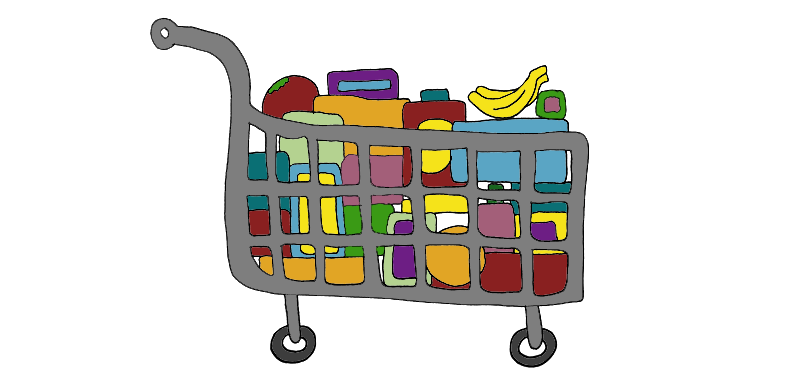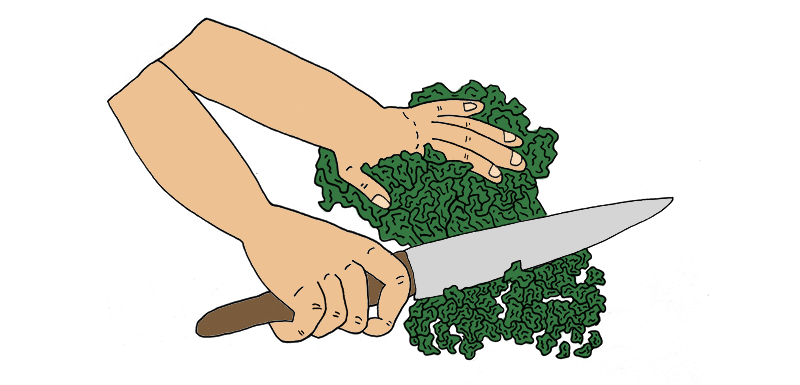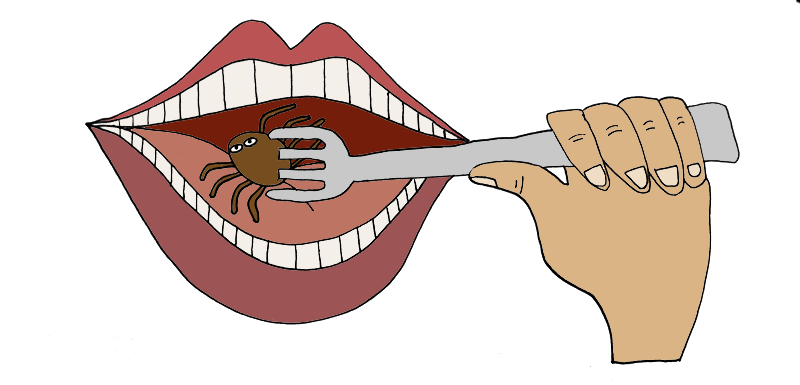I grew up in the 1950s and ’60s, and my mother was a working woman who didn’t like to cook. Although she dutifully made dinner for us every night, these were perfunctory and repetitive meals: meatloaf made with Catalina salad dressing, spaghetti with tomato sauce and occasional meatballs (also made with Catalina salad dressing), roast chicken (overcooked), and instant chocolate pudding or Jello for dessert. I looked with envy at my friends whose stay-at-home moms prepared things like veal parmigiana and shrimp scampi, baked alaska and pineapple upside-down cake.
At the time, convenience foods were sparse, limited mostly to canned foods. For many years, my idea of vegetables were greenish things floating in yellowish liquid that were dumped in a saucepan for 30 minutes so whatever taste and nutrition they contained had been boiled away. Another familiar adjunct to our meals was cream of mushroom soup — flavored lard to be added to casseroles, dips, or anything that needed a fat and sodium boost. Also, pork and beans: snippets of fat drowning in a salty mush and introduced alongside the occasional boiled hot dog (my mother saw hot dogs as low class but made an exception by serving them under the name of frankfurters). Finally, there was the much-loved macaroni and cheese — elbow macaroni and Velveeta — served to us when our parents went out for dinner.
Later in my childhood, frozen foods came into vogue. Swanson’s frozen dinners had been introduced in the early 1950s under the trademark of “TV dinners,” but we rarely had these, since my mother decided that they, like hot dogs, were low class. I believe the branding, “TV dinners,” put her off. As an educated woman of the 1950s, she had disdain for television, and the idea of eating in front of it struck her as akin to eating in one’s underwear. Being a good Democrat, she was not swayed by the fact that the then-President and his wife enjoyed their meals in front of the TV. I was reminded of this when I visited the Eisenhower home in Gettysburg, PA, and saw the little tables in the living room where Ike and Mamie used to eat dinner while watching Gunsmoke.
Frozen vegetables, however, were OK, and we understood vaguely that they were healthier than the canned stuff. I recall many a meal in which a rock-solid box of string beans was defrosted and served as a soggy accompaniment to a baked potato and Catalina meatloaf. Our reliance on frozen foods would be briefly suspended in the summer when my father had a garden, though the time window here was small, his lettuce and string beans being mostly eaten by the rabbits in the area. The one thing that invariably survived was rhubarb, which he boiled for hours with large heaps of sugar and served to us in lieu of the more preferred instant chocolate pudding.
I spent college on a meal plan (which I liked, given what I had to compare it with). During my single years afterward, I subsisted on salads from the many Korean markets in my neighborhood (this was Manhattan in the 1980s). I had packed on a few pounds owing to all that cream of mushroom soup, and I tried valiantly to lose weight with salads and Tab, a diet drink to which everyone I know became addicted (it is still produced, though in smaller quantities, and there are people who have squirreled away cases as one would stock an air raid shelter).
When I finally had a family later in that decade, I found myself following in my mother’s footsteps. I too hated to cook, evidence of the rule that one either copies one’s mother or reverses her, which I suppose covers all the bases. But like her, I felt that, having procreated, I had to feed the little brats and could not bring myself, like a shameless neighbor, to serve them cereal for dinner. Hence, the return of Catalina meatloaf, roast chicken, and spaghetti. I also added an item that my husband became attached to during his bachelor days: shake and bake chicken. This was chicken coated with a vaguely metallic bread crumb seasoning and put in the oven to be forgotten until you were ready to eat. Salad, which I had discovered in my 20s, also became a staple, though the addition of large wallops of salad dressing cancelled the health benefits. We mostly used Paul Newman dressing under the illusion that it had to be okay since Paul Newman was such a wholesome figure and I had a crush on him ever since seeing Exodus when I was seven years old.
I had been serving the above-mentioned Catalina meatloaf et al. to my grumpy family for several years, when I was elated to discover that a specialty grocery store in our area was selling prepared foods. At the vanguard of this trend in South Jersey where I lived was a market known as Zagarra’s, owned by an Italian family with a culinary bent. The prepared foods seemed like something dropped from heaven. You could buy veal parmigiana and shrimp scampi, those much-envied entrees that the stay-at-home moms used to make. These were now available to me and my children, albeit for a small fortune. Zagarra’s prepared foods were loaded with fat, sugar, and salt, but who thought about such things then, since the unhealthiness of the food wasn’t being waved in our face. (Our current health-conscious culture is good for our well-being but bad for our enjoyment, since it’s very difficult to take pleasure in, say, a corn muffin when a sign next to it tells you that it contains 300 calories and 20 grams of fat).
Eventually, even the more populist supermarkets began to sell prepared foods, so that if you were going to buy unhealthy prepared food, you might as well buy it cheaply at Acme. Interestingly, the more these foods became ubiquitous, the less impressive they seemed or perhaps the more discriminating I became. Leave a slab of lasagna under plastic for six hours and, once the novelty of being able to buy it wears off, who needs it?
As my children grew, the chore of feeding them became greater. They were no longer little brats, they were big brats, and their tolerance for Catalina meat loaf began to diminish precipitously, with the result that they were constantly making forays to WaWa for Italian hoagies. Eventually they left the nest and were caught up in their generation’s awareness of health and fitness, though I know that their default mode is still a WaWa Italian hoagie. It’s like I got them hooked on a drug habit that they can kick for awhile but which will always relapse. The consolation is that it’s not a drug habit. I know that when they find themselves under stress, instead of taking refuge in coke, they resort to Coke.
During this period of liberation from the family dinner, there was a marked improvement in both the palatability and the health of TV dinners, which brilliant marketers had managed to uncouple from TV (though now that TV has gotten good it may be time for retro-branding). Recently, my husband and I discovered Lean Cuisine, which trumpets its calorie, fat, and sodium content on the front of the package. This allows me to decide whether I will settle for the 250-calorie Vermont white cheddar mac and cheese or splurge on the 330-calorie sesame chicken.
I recently signed on for a new meal convenience, Blue Apron, which, each week, delivers a box of fresh ingredients to one’s home and directions for assembling them — with illustrations, for those, like me, who have a hard time following a recipe. These dinners are to gourmet meals what color-by-number is to fine art, but their advantages are many. For one thing, they cut down on grocery bills since every item needed for a meal is included without wastage, down to a single tomato or scallion. Thus, I no longer buy anything at the supermarket except toilet paper, toothpaste, and olive oil, the latter being the base ingredient for every Blue Apron recipe.
The meals are also relatively healthy. This is evidenced by the predominance of kale. The downside is that you are expected to eat a lot of kale.
Blue Apron meals look good on the plate in case you are inclined to take a pic for your Instagram page (not that I’m on Instagram). And they are not unpalatable. Still, after a while, they begin to lose their allure. First, because they take a long time to prepare (despite assurances of 25-35 minutes, you have to be a genius with a knife to chop all that kale in such a short period) and a very long time to clean up afterward (given the olive oil splatter). I shouldn’t complain since both the prep and the cleaning up are done by my husband, who recently retired. But he has such a long-suffering expression on his face while he does these things that, sometimes, I agree to chop the kale.
But it’s not just the kale-chopping and olive oil splatter that is the problem. It is the fact that these meals don’t “make your taste buds stand up and shout for joy” (a phrase that my father coined when a Catalina meat loaf that my mother made particularly pleased him). Those behind the creation of these recipes are putting them together with an eye to health, efficiency, and variety and the algorithms involved in maintaining a balance of these variables just doesn’t result in delectation.
Which brings me, finally, to the last refuge of the hungry: eating out, the dining experience that should, income allowing, make possible an excellent meal on a regular basis. Eating out was never much of an option when I was growing up. My family did not have the disposable income to eat out often and, when we did, there wasn’t much to choose from beyond Cantonese Chinese restaurants and overpriced steak houses.
This has since changed dramatically. I live in a city, Philadelphia, that has experienced a restaurant Renaissance over the past decade, and on a street in that city known as “restaurant row.” I now have enough disposable income to sample what’s out there, which includes everything from Northern and Southern Italian, Asian fusion, Cajun, Indian, and Mexican, not to mention gourmet vegan and Ethiopian.
And yet, despite the cornucopia of choices, I am not more satisfied. I find that most Italian food tastes pretty much the same (even in South Philly), and that Mexican food disagrees with me, especially if I forget to bring Beano. I have a lurking suspicion that I am being ripped off at many much-touted destinations, which impairs my enjoyment. On the few occasions that the meal is genuinely excellent, this is rarely repeated on a second visit. My husband speaks wistfully about an exceptional veal chop he had in the 1980s at Sammy’s Roumanian Restaurant on the Lower East Side of Manhattan, but when we returned years later the chop was less tasty. Expensive restaurants can be memorably disappointing in other ways as, for example, my experience at an expensive locavore restaurant in Philly, where the salad arrived with a giant spider on top, a signal, I suppose, of freshness and additional protein.
By now, you probably think I’m like the Princess and the Pea when it comes to meals, and you’d be right: a minor infraction — a dirty knife, a tepid bowl of soup, a frozen pat of butter, a spider — will sink the experience for me. As a critic by nature, I am attuned to discerning flaws. Perhaps food is connected to my quest to repair the mild deprivation of having a working mother with limited culinary skills. That said, I don’t know if any meal has quite equaled the taste of my mother’s Catalina meatloaf on a good night. Maybe food and the past are so deeply intertwined that nothing in the present can ever come up to snuff.
Or maybe the problem lies with my sense of taste. Taste buds are fragile organs, and what is tasty is changeable and subjective. Unlike sight and sound, where one can summon up a lost image or melody, it is difficult to summon up a lost taste. The great meal has taken on for me a Platonic form. I no longer even hope to experience it, and know, if I do, it will evaporate from memory like lost love.
But perhaps the issue here is a larger, philosophical one regarding the nature of satisfaction. A satisfying dinner is, like most everything in life, a moving target. My husband had a stay-at-home mother who served a carefully prepared three-course meal each night that he didn’t appreciate much. It is human nature to get used to even the best things that occur with any regularity — to feel that something is missing, no matter how objectively good (assuming there is such a thing as objectivity) or what improvement is made in delivery. Dissatisfaction is the engine of innovation which strives ceaselessly to fill the maw of ever-changing want.
Which is why the roast beef au jus and tilapia with almonds behind the glass counter of Wegman’s no longer entices me. And why, I suspect, the rich are not happier than I am despite their access to three-star Michelin restaurants and live-in chefs. •
All images by Isabella Akhtarshenas.








